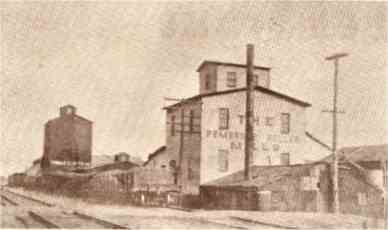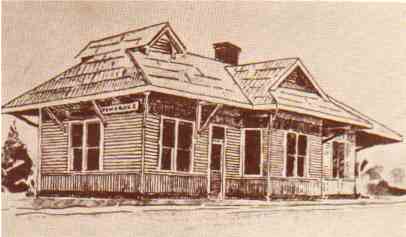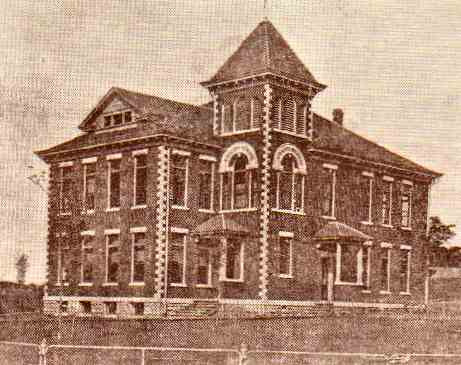Pembroke
The town of Pembroke dates back to about the year 1848,
when the need for a post office was felt by the planters living ten miles
southeast of Hopkinsville. Dr. Lunsford Lindsay took the lead in
securing the establishment of a post office. He was a man of literary
attainments and fond of "Thaddeus of Warsaw," one of the popular books
of the day, and greatly admired the character of Lord Pembroke. Therefore
he gave the name of Pembroke to the new post office. He lived on
a farm afterwards owned by James A. Payne and kept the office at his his
place until 1850, when it was removed to another residence on the Nashville
road, where Sutton L. Hunter later kept a country store. This store
was bought by R. C. Jameson in 1852 and was moved to the crossing of the
Nashville and Tobacco roads. The two-story building was drawn down
the road on rollers by ten yokes of oxen. The old building was burned
in 1880. This was the beginning of Pembroke.
The next building was a blacksmith's shop. The town as it
now exists was laid out on parts of four farms subsequently owned by R.
C. Jameson, A. G Slaughter, James Richardson and E. B. Garnett. In
1852 Faulkner and Slaughter bought the Jameson store and enlarged its business.
They employed W. W. Garnett, one of a family of four boys, who eventually
became leading citizens. He was then only fourteen years old.
W. T. Oliver next erected a house and used it for a tinshop and grocery,
and later sold it to A. Rust. There were frequent changes in the
mercantile houses and finally Richardson & Williams became proprietors
of the leading store which in 1858 was sold to W. H. Pendleton, W. W. Garnett
and E. G. Buck. As W. H. Pendleton & Company, they were running
in 1861 and closed down when all of the members of the firm entered the
Confederate Army.
 Pembroke Roller Mills, 1898.
Pembroke Roller Mills, 1898.
Built by Walter S. Bumpus in 1897 and opened March 15, 1898.
This flour mill was bought in 1925 by V. H. Burchett. Upon his retirement
in 1961, the mill machinery was dismantled and sold.
|
A dry goods house and a grocery or two were kept in operation
during the war, but the town was at a standstill. Josh Cowardin,
a tailor, was the postmaster and kept the office in an upper room of the
old storehouse. He wa a little man who came from Virginia and later
moved to Fairview and died of cholera about 1869. The tobacco business
was started in 1854 when A. Rust, A. G. Slaughter, James Richardson and
R. C. Jameson opened a stemmery. The firm was afterwards Richardson,
Jameson & Company and it build up a big business in America and Europe.
This firm was succeeded by W. D. Garnett & Sons, then by Garnett and
Lloyd, and finally by Garrott, Jameson & Company. From the beginning
of 1901 the town had five tobacco houses. The others were operated
by R. R. Lloyd and Son, Graham & Eddins and A. O Dority.
Tobacco marketing has greatly changed during the last twenty five years,
but the tobacco business is still one of the towns principal industries.
In the early days of the town's history, the physician were Dr. Conley,
S. C. Payne, N. L. Porter, L. F. Chilton and J. D. O'Brien, all fine doctors.

Pembroke L & N Railroad Station
Drawing by James A. Johnson, 1954
|
In 1868 the L & N Railroad was completed and Pembroke was incorporated
and became a real town, that grew rapidly and prospered greatly.
A. G. Slaughter, D. S. Hord, James Richardson, R. C. Jameson, and J. D.
O'Brien were the first trustees, John P. Billingsly, police judge, and
Major A. Rust, marshal. G. L. Slaughter was elected City Attorney.
At this period W. W. and J. P. Garnett and Massie & Company were
the merchants. O'Brien & Walker ran a drug store and there were
groceries and workshops, livery stables and other business houses.
The town was soon well provided with churches, schools and fraternal societies
and was a hustling little town with improved streets and nice residences.
Pembroke had made for itself a place on the map of Kentucky.
 Pembroke School, opened in September of 1901 with C. D. Dudley
as Principal. The school burned on September 21, 1940 and was rebuilt.
Pembroke School, opened in September of 1901 with C. D. Dudley
as Principal. The school burned on September 21, 1940 and was rebuilt.
|
A History of Christian County
Charles M. Meacham, 1930
Gateway From The Past
William Turner,1981
©2001
All Rights Reserved
Photos used with permission of William Turner, Historian

|



